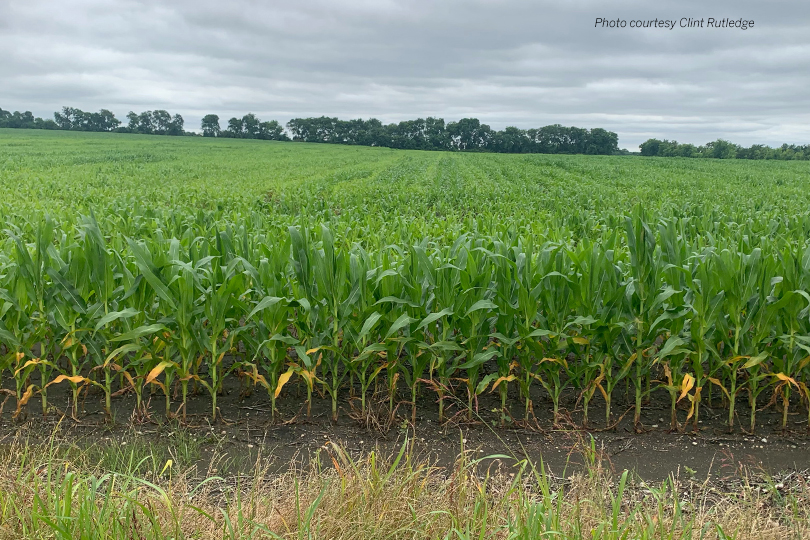By Jennifer Whitlock
Field Editor
Texas weather remains one of the top stories in 2021. First it was too dry, then it was too cold. Now, it’s too wet.
“The weather sure is keeping us on our toes this year,” Clint Rutledge, a Grayson County farmer and rancher, said. “It’s all feast or famine. It doesn’t seem like there’s any in-between anymore.”
In North Texas, where Rutledge farms corn and wheat and raises cattle, the crop year was off to a good start. After making it through a drier winter followed by the freezing Arctic blast, timely moisture had conditions looking up for farmers and ranchers across the area.
“We had the best planting season and the best-looking wheat crop I’ve ever seen. The corn was looking really good, and things were going well,” Rutledge, Grayson County Farm Bureau vice president, said. “But then the rains came. The last day I worked in the field was Mother’s Day, and that’s been nearly a month ago now.”
What was looking like 200-bushel per acre corn is now beginning to yellow at the bottom, a sign of nitrogen deficiency and stress from standing in water too long.
And while the wheat crop looks okay right now, it’s suffered, too. A freeze in late April caused some frost damage, and if the rain keeps up, the grain will begin to sprout in the heads before he can harvest it, further lowering quality and yields.
“This has just been a weird year. I can’t believe how cool it is. It hasn’t even hit 90 degrees here yet,” Rutledge said. “We are fortunate that our wheat was at a stage when that late freeze hit that it wasn’t hurt as bad as some other guys further north of me, but it definitely affected it. Now, I have about 450 acres of grazing wheat I’d like to start cutting soon, depending on if the rain will hold off long enough for the fields to dry out a bit where I can get out in them. I’d say in another week or so we’ll know for sure what’s going to happen, but in farming, you just really don’t know.”
Some farmers are putting tracks on their combines to get in the fields and cut wheat, but at about $50,000 per set, it’s an expensive proposition Rutledge hasn’t yet invested in. Rutledge noted his combines are at least four-wheel drive, an option many farmers forego when purchasing already-costly equipment.
If the weather cooperates, he hopes to begin harvest next week. Before the freeze, he was predicting 70 to 80-bushel yields per acre. Now, he expects yields to be closer to 50 or 60 bushels an acre.
But things could always be worse.
“Back in 2015, it was really wet like this, and we lost all our wheat and had a lot of sprout damage,” he said. “You always remember all the bad years. Right now, I think we’re fairly lucky with our wheat crop, and I think it’s going to be okay.”
He’s more concerned about the development of the corn crop, which is planted and matures later than wheat.
His corn that was planted earlier in the spring and received nitrogen fertilization looks “phenomenal,” according to Rutledge. He normally side-dresses all his corn, but he noted the rest was sprayed by a crop duster since it’s too wet to get in the fields.
Sprayers and row crop rigs cost about $6 an acre for application, and hiring an aerial applicator costs $8 to $8.50 an acre. But because corn prices are currently over $6 per bushel, it’s worth the added expense.
“It’s been a long time since we had to hire out to get our spraying done by air,” Rutledge said. “We live and farm around these housing developments, and I’ve gotten some complaints about the crop dusters flying so low and flying around the houses, but it has to be done. There’s no other way to get to it right now.”
Corn that was previously growing quickly has stalled with the cooler temps and continued rain. The earlier-planted crops were at the V8 or V9 stage when it started raining and are doing well because they can take more moisture. However, the corn he planted later was only at the V4 to V6 stage and doesn’t need as much rain, so it’s struggling.
But again, things could always be worse.
“I feel really lucky because I’ve seen some of my friends’ corn north and east of here, and it looks terrible. They got started planting later because it was too cold or too wet, and they’re really suffering,” he said.
It’s too wet for Rutledge to move cattle and wean calves, too.
For now, all he can do is wait and see what the weather forecast holds.
“We were on the verge of having what I like to call a ‘grand slam’ year. We had all our corn planted for the first time in two years. Our stand looked really good, and we had the prices for once. Wheat is over $6.50, and corn is over $6. So, if we could hit that home run this year it sure would be nice,” Rutledge said. “But in farming, you just have to rely on the good Lord and faith. He’s brought us this far, and He’ll carry us through. That’s about all I really know at the end of the day.”
Click here to read more about the weather impacts on the Texas Hill Country.


Very puzzling weather this year!
Hope it works out for our ranchers
To end good or at least OK
Wendell